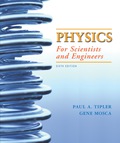
Concept explainers
(a)
To calculate:
Calculate the derivative of speed of the sound in air as respect to absolute temperature.
(a)
Answer to Problem 34P
Derivative of the speed of the sound in air as respect to absolute temperature is
Explanation of Solution
Given:
Differentials
Formula used:
Calculation:
The speed of sound in a gas is given by
Where,
To estimate the percentage change in the speed of sound if the temperature increases from
For evaluating the
Now, to separate the variables to obtain,
Conclusion:
Derivative of the speed of the sound in air as respect to absolute temperature is
(b)
To calculate:
The percentage change in speed of the sound when temperature changes from
(b)
Answer to Problem 34P
The percentage change in speed of the sound when temperature changes from
Explanation of Solution
Given:
Differentials
Temperature
Temperature
Formula used:
Calculation:
The given equation is:
First differentiate the expression with respect to
To estimate the percentage change in the speed of sound if the temperature increases from
Approximate the
Put the numerical values to get,
Conclusion:
Thus, the percentage change in speed of the sound when temperature changes from
(c)
To calculate:
Calculate the value at
(c)
Answer to Problem 34P
The value at
Explanation of Solution
Given:
Speed of the sound
Temperature
Formula used:
Calculation:
According to the question,
Using the differential approximation, approximate the speed of sound at
Now, put the numerical values and evaluate the
Conclusion:
Thus, the value at
(d)
To explain:
Calculate an approximation comparison with result of an exact calculation.
(d)
Answer to Problem 34P
Approximation comparison with result of an exact calculation
Explanation of Solution
Given:
Speed of the sound
Temperature
Formula used:
The speed of sound wave at the absolute temperature is:
Here,
- Molecular mass of hydrogen:
Constant (hydrogen is diatomic gas):
Absolute temperature:
Gas constant:
Calculation:
The speed of sound wave at the temperature
The speed of sound wave at the temperature
Now, divide the first of these equations by the second and solve for
And,
Conclusion:
Approximation comparison with result of an exact calculation
Want to see more full solutions like this?
Chapter 15 Solutions
EBK PHYSICS FOR SCIENTISTS AND ENGINEER
- Consider a sound wave moving through the air modeled with the equation s(x,t)=6.00nmcos(54.93m1x18.84103s1t) . What is the shortest time required for an air molecule to move between 3.00 nm and -3.00 nm?arrow_forwardIf the maxwell’s wheel were to rotate twice as fast, how much would its kinetic energy increase?arrow_forwardAn airborn radar of an airoplane has a pulse width of 5µ sec, at a vertical height of1nautical mile,A. find the lateral ground distance on earth to land,B. find the angle to be maintained for proper landing with above values.arrow_forward
- A tungsten fi lament of a typical incandescent lightbulboperates at a temperature near 3000 K. At whatwavelength is the intensity at its maximum?arrow_forwardAssume the mostly infrared radiation from a heat lamp acts like a continuous wave with wavelength 1.50 µm . If the lamp’s 200-W output is focused on a person’s shoulder, over a circular area 25.0 cm in diameter, then how long will it take to increase the temperature of the 4.00-kg shoulder by 2.00°C, assuming no other heat transfer and given that its specific heat is 3.47 × 103 J/kg. °C ?arrow_forwardWhat is the difference between propagation speed and the frequency of a mechanical wave? Does one or both affect wavelength? If so, how?arrow_forward
- A steel wire in a piano has a length of 0.800 m anda mass of 4.30 grams. To what tension must thiswire be stretched to make the fundamentalfrequency correspond to middle C, (fc = 261.6Hz)?arrow_forwardHow come the equation is f0 = Wo/h and not E = hf? Is it because threshold frequency correlates with work function while frequency correlates with total energy?arrow_forwardAssume the radiation from a heat lamp is monochromatic, with a wavelength of 1.5 μm . If the lamp’s 182.75-W output is focused on a person’s shoulder, over a circular area 26.5 cm in diameter, what is the intensity in kilowatts per square meter?arrow_forward
- The intensity of solar radiation at the top of Earth’s atmosphereis 1 370 W/m3. Assuming 60% of the incoming solar energyreaches Earth’s surface and assuming you absorb 50% of theincident energy, make an order - of - magnitude estimate of theamount of solar energy you absorb in a 60 - minute sunbath.arrow_forwardIf you stood at the same point on a cold day were T2 = -7.5 °C how long is have taken fou u to hear the echo in s?arrow_forwardWhat is the intensity in W/m2 of a laser beam used to burn away cancerous tissue that, when 94.0% absorbed, puts 540 J of energy into a circular spot 2.20 mm in diameter in 4.00 s? Discuss how this intensity compares to the average intensity of sunlight (about 700 W/m2) and the implications it would have if the laser beam entered your eye. Note how your answer depends on the time duration of the exposure.arrow_forward
 University Physics Volume 1PhysicsISBN:9781938168277Author:William Moebs, Samuel J. Ling, Jeff SannyPublisher:OpenStax - Rice University
University Physics Volume 1PhysicsISBN:9781938168277Author:William Moebs, Samuel J. Ling, Jeff SannyPublisher:OpenStax - Rice University Classical Dynamics of Particles and SystemsPhysicsISBN:9780534408961Author:Stephen T. Thornton, Jerry B. MarionPublisher:Cengage Learning
Classical Dynamics of Particles and SystemsPhysicsISBN:9780534408961Author:Stephen T. Thornton, Jerry B. MarionPublisher:Cengage Learning University Physics Volume 3PhysicsISBN:9781938168185Author:William Moebs, Jeff SannyPublisher:OpenStax
University Physics Volume 3PhysicsISBN:9781938168185Author:William Moebs, Jeff SannyPublisher:OpenStax Physics for Scientists and Engineers, Technology ...PhysicsISBN:9781305116399Author:Raymond A. Serway, John W. JewettPublisher:Cengage Learning
Physics for Scientists and Engineers, Technology ...PhysicsISBN:9781305116399Author:Raymond A. Serway, John W. JewettPublisher:Cengage Learning Physics for Scientists and Engineers: Foundations...PhysicsISBN:9781133939146Author:Katz, Debora M.Publisher:Cengage Learning
Physics for Scientists and Engineers: Foundations...PhysicsISBN:9781133939146Author:Katz, Debora M.Publisher:Cengage Learning




